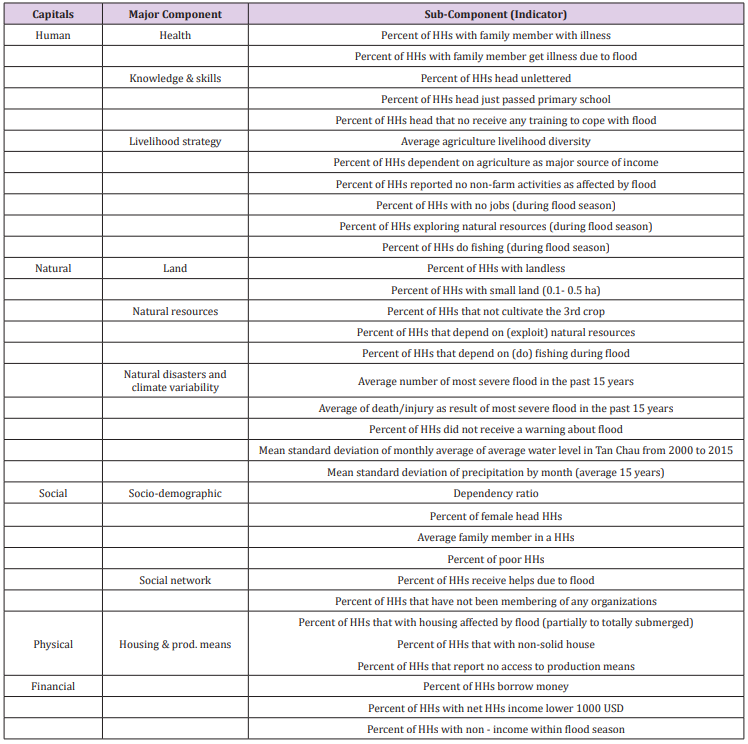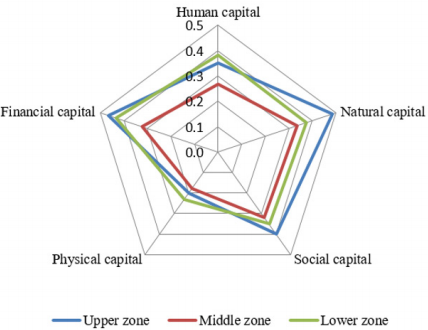Carnosic Acid and its Derivatives: Diterpenes of Biological Interest
Introduction
A Giang is a province in the Mekong downstream area influenced by annual flood. Flood brings large amounts of silt to build up and improve soil fertility; field sanitation, washing alum Dao Cong Tien [2], creating jobs and income for people in the flooding season such as fishing, vegetables and travel services. Besides, the floods also cause damage to agriculture, livelihoods of people in floodplains; specifically, the flood lasts from October to November by Mekong water combined with heavy rain water causing flood in most of the districts in the province and urban areas during big floods. Low areas covered in water from 1.5 m to 4.5 m causing huge damage to property and people’s lives (Irrigation Department of A Giang [3]). However, only few studies assess the vulnerability of flood due to people’s livelihoods changes in flooding areas (at the upstream, middle and downstream) in a comprehensive way considering all aspects (human, natural, financial, physical and social ones) under the increasing effect of climate change and flood changes for appropriate solutions to reduce the vulnerability of people’s livelihoods in flooding areas. Therefore, the research on “Applying livelihood vulnerability index in studying livelihood: A case study in A Giang province, in the Mekong Delta, Vietnam” is considered as a basis reference which proposes necessary solutions to improve people’s livelihood effectively and sustainably.
Research Objectives
a) Assessing vulnerability and adaptability to the flood changes in different conditions on farmer livelihoods.
b) Proposing strategic solutions to reduce vulnerability from flooding in the context of climate change on farmer livelihoods.
Research Methods
Constructing Livelihood Vulnerability Index(LVI)
This study adopts the sustainable Livelihood Framework (Birkmann [4]) to guide the assessment of livelihood vulnerability to floods. The Sustainable Livelihood Framework (SLF) where vulnerability context is major determinant of sustainability of livelihood assets as it directly influences livelihood strategies, institutional process and livelihood outcomes of community (Chambers and Conway [5]; DFID [6]). The effects of floods and climate variability have been considered under the vulnerability context of SLF. The level of vulnerability of community determines the impacts of floods and climatic conditions on people’s livelihood assets, strategies and outcomes. This study aimed at caculating level of vulnerability to the impacts of those extreme floods and climate variability in three diffrent floods communes such as upstream commune (Phu Huu), middlestream (Vinh An) and downstream (Vinh Phuoc) of An Giang province, Mekong Delta of Vietnam by applying a LVI that development by Hahn et al. [1]. The components that are the indicators of vulnerability of community to flood impacts are presented in Table 1. These components are classified under 5 different livelihood assets in SLF: human, physical, social, natural, financial. The sub-components have been developed as indicators under a single component which are shown in Table 1.
Calculating the Livelihood Vulnerability (LVI)
The information was collected by interviewing 180 households in upstream commune (Phu Huu), middlestream (Vinh An) and downstream (Vinh Phuoc) and Livelihood Vulnerability Index (LVI). According to Hahn et al (2009), LVI is applied to assess the impact of flood damage to the livelihoods of people in flooding areas. LVI index has two approaches: (1) LVI is represented as a compound index including seven major factors (household characteristics, livelihood strategies, social networking, health, food, water, natural disasters and climate change), each main factors including a few indicators or additional factors; (2) seven key elements combine into the three “contributing agents “ including exposure, sensitivity / and adaptability (as defined by the Intergovernmental Panel on Climate Change IPCC - Intergovernmental Panel on Climate Change). Each additional factor measured in different system and should be standardized as an index according to the following equation:

Once standardized, additional factors are averaged to calculate the value of each element by the following equation: Once values of the key elements are identified, local livelihood vulnerability index (communal level) is calculated according to the equation:

LVI is about [0,1], LVI the closer to 1, the higher vulnerable rate.
LVI-IPCC: LVI of p commune is calculated by using IPCC.
LVI IPCCp = (ep - ap)* Sp (value ranges from -1 to 1)
IPCC: CFP - is defined as the main components of the level of exposure, sensitivity, adaptive capacity for each p commune.

Key components of the level of influence (e) include climate change; capacity of adaptation (a) the household characteristics, livelihood strategies and social networks; sensitivity level (s), including the main components of knowledge, skills and health care, natural resources such as land and finance.
Results and Discussion
Assessment on Vulnerability to Flood Changes on the Livelihoods of Farmers in an Giang Province
Through the analysis of sources and livelihood vulnerability index (LVI) of 10 key components, 30 subcomponents and 5 financial sources (Table 2 and Figure 1) show that the upstream is the most vulnerable area, specifically, livelihood vulnerability index (Average of H, N, S, P, F) in Phu Huu commune is the highest at 0,397; Vinh Phuoc commune at 0,357; and the lowest is Vinh an commune at 0,299. Within 5 financial sources, human, financial and social sources have high vulnerability index in all three regions; physical sources have the lowest vulnerability index.
Table 2: Vulnerability triangle of the contributing factors of the LVI-IPCC for Phu Huu, Vinh An and Vinh Phu communes.
Figure 1: Vulnerability diagram of five capitals of SLF of Phu Huu, Vinh An , Vinh Phuoc communes, 2016.
Vulnerability Index LVI-IPCC of 3 Research Areas Including Upstream, Midstream and Downstream
Results calculated in accordance to LVI-IPCC (level of influence, adaptability and sensitivity) based on the sub-components of household characteristics, livelihood strategies and social networks in three communes in Phu Huu Vinh An, Vinh Phuoc (Table 2) indicate that interviewed households in Phu Huu (upstream commune) with greater level of influence, sensitivity and adaptability than households in Vinh An and Vinh Phuoc; Vinh An commune (midstream) has lowest level of influence, sensitivity and adaptive capacity.
Conclusion and Recommendation
Floods are a natural phenomenon and occur annually. Complicated and irregular floods caused difficulties to people’s livelihood in An Giang province. Research findings on livelihood vulnerability index (LVI) including 10 key components, 30 subcomponents and 5 livelihood sources showed that people in Phu Huu commnue have the highest vulnerability. (With livelihood vulnerability index at 0,397), followed by Vinh Phuoc Commune (0,357), and Vinh An is the lowest (0,299). Besides, the results also indicated that one area that is more vulnerable will have higher adaptability. For instance, adaptability of Phu Huu is higher than Vinh An and Vinh Phuoc Commune (0,415 compared to 0,304 and 0,355). To reduce vulnerability, early warning systems should be developed to decrease flood damage to people’s livelihoods. Also, to prepare for the flood season, it is necessary to strengthen propaganda and dissemination of knowledge. Local authorities should organize training courses on unusual flood adaptation. Moreover, the government should have insurance policies for people in flooded areas to ensure their livelihood and reduce the vulnerability of climate change conditions.
More BJSTR Articles: https://biomedres01.blogspot.com/





No comments:
Post a Comment
Note: Only a member of this blog may post a comment.